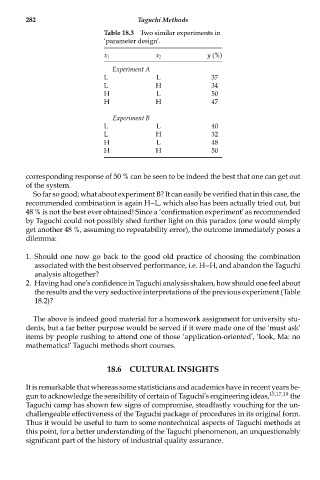Page 297 - Six Sigma Advanced Tools for Black Belts and Master Black Belts
P. 297
OTE/SPH
OTE/SPH
August 31, 2006
JWBK119-18
Taguchi Methods
282 3:6 Char Count= 0
Table 18.3 Two similar experiments in
‘parameter design’.
x 1 x 2 y (%)
Experiment A
L L 37
L H 34
H L 50
H H 47
Experiment B
L L 40
L H 32
H L 48
H H 50
corresponding response of 50 % can be seen to be indeed the best that one can get out
of the system.
So far so good; what about experiment B? It can easily be verified that in this case, the
recommended combination is again H--L, which also has been actually tried out, but
48 % is not the best ever obtained! Since a ‘confirmation experiment’as recommended
by Taguchi could not possibly shed further light on this paradox (one would simply
get another 48 %, assuming no repeatability error), the outcome immediately poses a
dilemma:
1. Should one now go back to the good old practice of choosing the combination
associated with the best observed performance, i.e. H--H, and abandon the Taguchi
analysis altogether?
2. Having had one’s confidence in Taguchi analysis shaken, how should one feel about
the results and the very seductive interpretations of the previous experiment (Table
18.2)?
The above is indeed good material for a homework assignment for university stu-
dents, but a far better purpose would be served if it were made one of the ‘must ask’
items by people rushing to attend one of those ‘application-oriented’, ‘look, Ma: no
mathematics!’ Taguchi methods short courses.
18.6 CULTURAL INSIGHTS
It is remarkable that whereas some statisticians and academics have in recent years be-
gun to acknowledge the sensibility of certain of Taguchi’s engineering ideas, 15,17,19 the
Taguchi camp has shown few signs of compromise, steadfastly vouching for the un-
challengeable effectiveness of the Taguchi package of procedures in its original form.
Thus it would be useful to turn to some nontechnical aspects of Taguchi methods at
this point, for a better understanding of the Taguchi phenomenon, an unquestionably
significant part of the history of industrial quality assurance.

